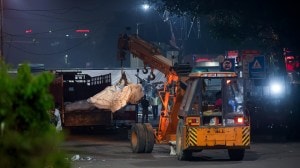Holding excess water in Hathnikund barrage could lead to bigger damage: Haryana Education Minister
His comments came a day after Delhi Chief Minister Arvind Kejriwal in a letter to Union Home Minister had requested that "if possible, the water from the Hathnikund barrage in Haryana be released in limited speed".
 The water from this barrage normally takes 72 hours to reach Delhi but officials believe it may have reached early this time because of the high volume of the water in the river. (PTI Photo)
The water from this barrage normally takes 72 hours to reach Delhi but officials believe it may have reached early this time because of the high volume of the water in the river. (PTI Photo) Amid the blame game over water flow from the Hathnikund barrage increasing the Yamuna level in Delhi, Haryana Education Minister Kanwar Pal Thursday said not releasing excess water from the barrage could lead to a “bigger damage”.
“When there are floods or heavy rains as we saw in neighbouring Himachal Pradesh and even in our state in the last few days, there is no option but to release water. If we hold the water, the situation will be disastrous,” the minister told PTI. Pal said the Hathnikund barrage in Haryana’s Yamunanagar district does not have a mechanism to store large volumes of water like a reservoir, adding that if water is held in the barrage beyond a permissible limit, a “bigger damage” could be caused.
His comments came a day after Delhi Chief Minister Arvind Kejriwal in a letter to Union Home Minister had requested that “if possible, the water from the Hathnikund barrage in Haryana be released in limited speed” and pointed out that the national capital is set to host the G20 Summit meeting in a few weeks.
Meanwhile, in what could be a relief to the flood-like situation in the national capital and Haryana villages in the coming days, the water level in the Hathnikund Barrage located on the Yamuna river in Haryana’s Yamuna Nagar district has witnessed a sharp decline in the river.
The water from this barrage normally takes 72 hours to reach Delhi but officials believe it may have reached early this time because of the high volume of the water in the river. According to the officials, the decrease in rain in the hills is the main reason behind the reduction in water level in the river at Hathnikund Barrage.
An official of the state irrigation department told The Indian Express that the water level at the barrage was measured at 1.4 lakh cusecs on Thursday noon while it was 1.62 lakh cusecs at 10 am. At 11 am on Tuesday, 3.59 lakh cusecs of water was released into the Yamuna river from the barrage which was the highest mark of this season till now.
However, the Yamuna water level at Okhla Barrage continues to increase at a dangerous rate. Around 3.48 lakhs of cusec water is being discharged at the barrage currently, which is much higher than the projected discharge level.
Keeping in view of the rising water level, the Haryana government had already alerted officials to avoid a flood-like situation in Karnal, Panipat, and Sonipat districts. Due to the increasing level of flood water near Yamuna, Army was deployed in Tapu Kamalpur village of Yamuna Nagar on Thursday, said the official.
The Yamuna breached the danger mark in Delhi in August 2019, after Haryana had released a record 8.28 lakh cusecs of water into the river from Hathnikund Barrage. Before this, the highest record for water in the Yamuna at Hathnikund Barrage was 8.06 lakh cusecs in June 2013.
With the water level of the Yamuna river flowing at a high level, Delhi Chief Minister Arvind Kejriwal Wednesday sought the Centre’s intervention to ensure that it does not rise further. “There have been no rains in Delhi for the last three days. Water levels of Yamuna are rising not because of rains, but due to high volumes of water being released by Haryana at Hathnikund barrage,” CM Kejriwal wrote in a letter to Union Home Minister Amit Shah.
Pointing out that the news of the flood in the capital will not send a good message ahead of the G20 Summit, CM Kejriwal had urged Shah to release the water from Hathnikund barrage in Haryana at a controlled speed.
However, the officials of Haryana say the AAP government should be careful in issuing statements regarding the release of water from Hathnikund Barrage adding that there is no option of storing the water at the barrage but to release it further.
(With inputs from PTI)







